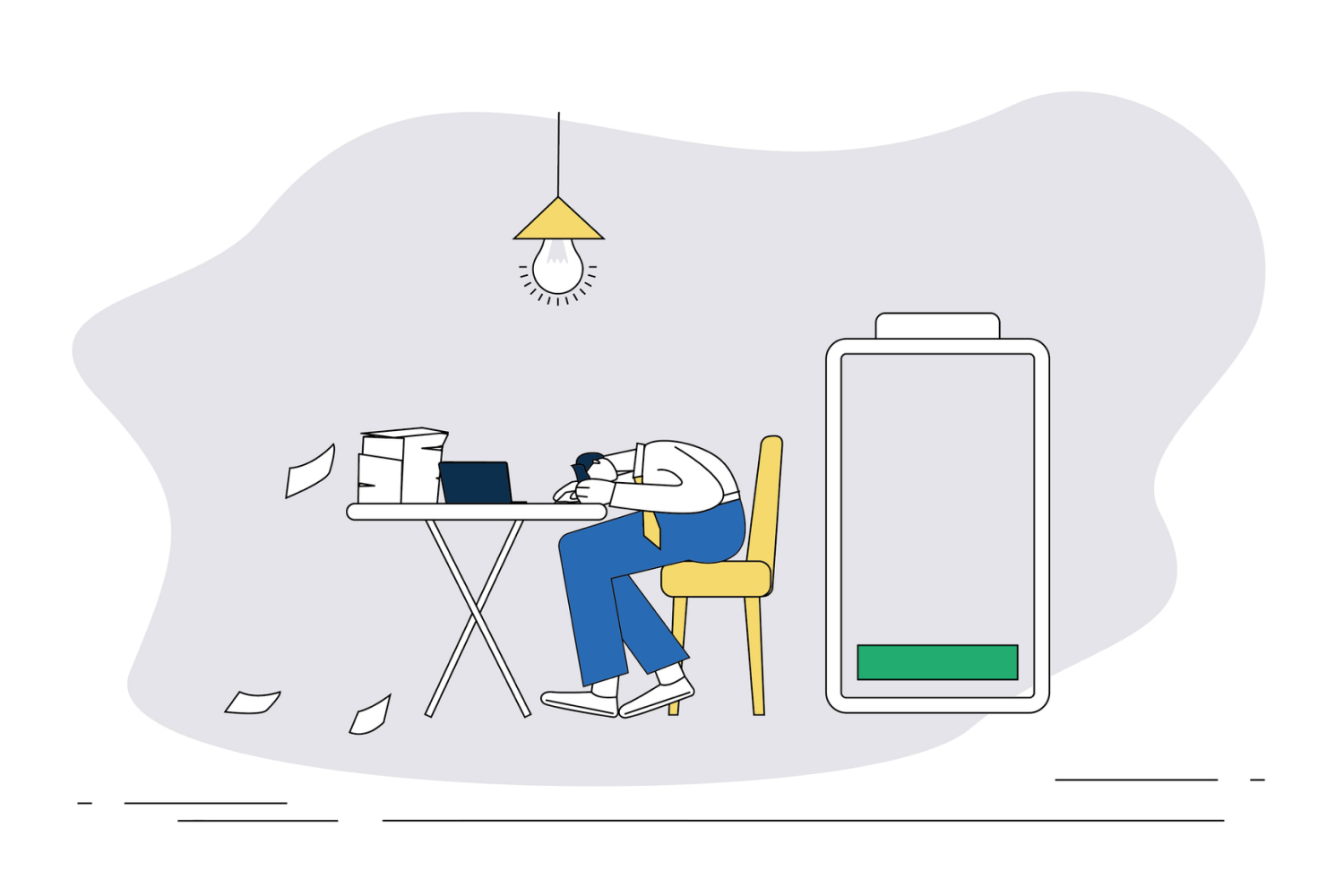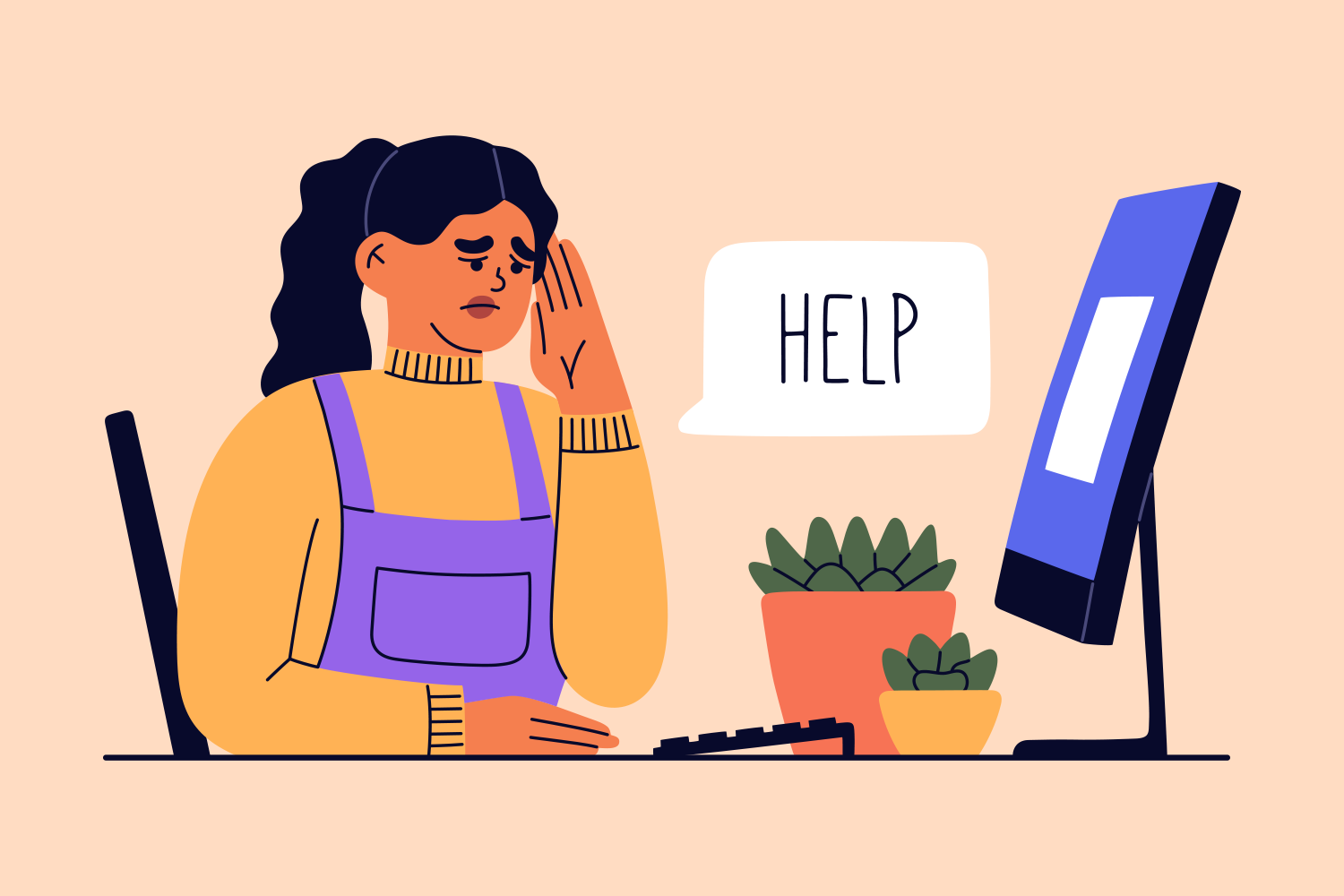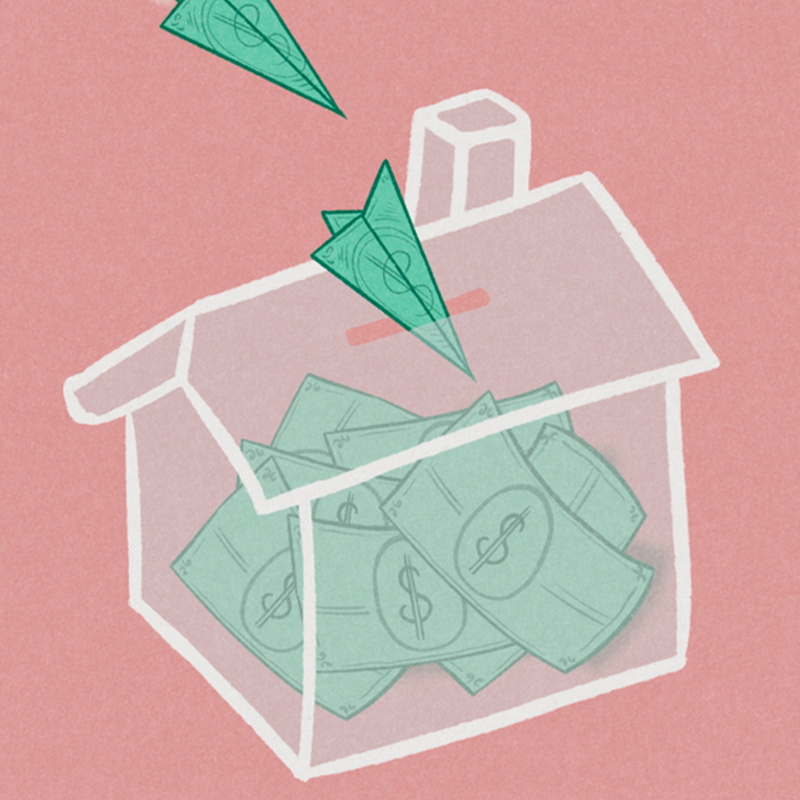Forget Zoom Fatigue—IRL Work Is Zapping Us

You’re back in the office—as in a real, physical place with cubicles and photocopiers and a communal fridge (hopefully not filled with mysterious Tupperware still lurking from March 2020). You’re buttoned up in your business-casual best, you’ve made small talk with Janine from accounting, and you’ve slipped back into the unspoken etiquette of it all—hovering outside a boardroom the second it hits the hour and never using a bathroom cubicle directly next to an occupied one—like no time has passed.
At the end of the day, you may have loved it, or you may have resented every moment of it, but it’s almost guaranteed that you were exhausted by it. Like, go to bed at 8 p.m. kind of wiped. Which seems bizarre when you consider that many of us used to go into an office five days a week. “How did I ever do it?” you might find yourself asking.
“This is definitely a common phenomenon among today’s employees,” says Elizabeth Christodoulou, a London, U.K.-based organizational psychologist. “Whether an employee is returning full time to the office or just a few days per week, it’s normal to experience feelings such as tiredness, fatigue or just general distress.” (In psychological terms,“distress” generally translates to anxiety, stress and/or depression.)
This, to be clear, isn’t the same thing as “Zoom fatigue,” that exhaustion that bowled us over at the beginning of the pandemic thanks to a combination of a) the world imploding around us b) the fact that seeing your face on a screen all day is uniquely taxing on the human brain. (Technical term? “Cognitive overload.” Or, as we like to call it, “Why did no one tell me I did that weird thing with my eyebrows?!”) This “office fatigue” is a new sort of tiredness, brought on by companies asking their employees to come back into physical workplaces.
So how do we navigate this reality? Let’s start with understanding why it’s making us so tired in the first place.
Why in-person work is suddenly so exhausting
Some of our collective tiredness has to do with how you may feel about going back to the office in the first place. Christodoulou points to a recent McKinsey survey that reported one-third of respondents felt returning to IRL work “had a negative impact on their mental health.” Factors include lingering concerns about catching Covid and the loss of flexibility in their schedule, according to the survey. But it can also be attributed to the accumulated load of, uh, stuff, you have to deal with in an office that just isn’t part of working from home, which can include commuting or putting on hard pants. And the “human to human” aspect—the small talk, the face-to-face meetings—can be particularly draining.
It’s not that we’ve forgotten how to be human, says Christodoulou, but rather that we’re fighting millenia of evolutionary conditioning to find new things stressful—even when they’re theoretically familiar. “A lot has actually changed. Think of social relationships, personal boundaries, meeting new hires you may not have seen before,” she points out. “The combination of gradually adjusting to a new environment, having a heightened awareness of the cues around us and overcoming social awkwardness after Covid-19 can spark feelings of stress and tiredness in employees.”
Dealing with office politics and being pulled from one in-person meeting to another can also lead to emotional depletion, says Christodoulou. “Meanwhile, the fact that employees may have less flexibility around how their day is structured can contribute to feeling less engaged at work.” In extreme cases, she adds, feeling this way consistently can contribute to burnout, which is essentially physical and emotional exhaustion.
And that’s if you weren’t nearing burnout already. As Christodoulou points out, many companies saw layoffs (or had employees leave as part of the “Great Resignation”) and it wasn’t unusual for remaining workers to be saddled with their former colleagues’ tasks in addition to their own. “Burnout during the return-to-office [phase] can also simply be the result of being overworked,” says Christodoulou. Tacking on a commute, small talk and the low level buzz of fluorescent lighting—all draining in their own ways—might be the equivalent of trying to get water from a dry well for many folks.
“The combination of gradually adjusting to a new environment, having a heightened awareness of the cues around us and overcoming social awkwardness after Covid-19 can spark feelings of stress and tiredness in employees”
Plus now, you’re also breaking two years of habits. Christodoulou says many of the scheduling changes we adopted over the last few years may have improved quality of life, like being able to hit the gym at lunch or pick your kid up from school. Those workouts, for example, may have given you the endorphin boost you needed to get through the day, while getting the chance to spend time with your family might also mean you’re taking a break you wouldn’t have if you were powering through a day in the office. After all, not all tiredness is necessarily physical. “It is important to consider that many employees were craving more flexible working patterns for years,” Christodoulou says.
The difference between fatigue and frustration
Koula Vasilopoulos, senior managing director at talent-solutions firm Robert Half, questions whether we are truly exhausted or whether what we’re experiencing is actually frustration with our work situations. She makes the link between the phenomenon of mass exhaustion and just a general reluctance to go back to the pre-pandemic status quo.
“It’s fair to assume that after two years of not having to commute, not having to think of ‘What do I wear,’ ‘What am I going to bring for lunch?’…there are a number of different considerations creating this fatigued feeling for people,” she says.
It certainly doesn’t help, she adds, that most in-office days still often involve video calls with folks who are not in the room. And now, you’re squeezing in IRL interactions—side-of-desk meetings, watercooler chats etc.—into an already jam packed schedule. Yes, you might spend WFH days on Zoom too, but you’re not also burning up mental energy making small talk with Brenda by the coffee machine, or spending three hours in soul-sucking traffic.
For Vasilopoulos, it’s key that employers recognize their employees might be feeling office frustration, and “lead with empathy and flexibility,” rather than try to shove a way of working down their reluctant (or just tired!) employees’ throats.
“It’s not [about] getting stuck on how you personally feel,” she says, speaking directly to the kind of leader who’d self-identity as “old-school” and who might not relate to an employee who says they’re struggling to balance productivity and having people wanting to speak with them IRL all day. (These bosses are often the same ones who came into the office alone during the pandemic, looking out with sadness from their corner office at their employees’ empty workspaces.) “What’s most important is how your employee is feeling. You need to listen to their concerns and ask how you can help them manage and alleviate some of those specific stressors,” she says.
How to combat office fatigue
Combating office fatigue does not necessarily involve the incentives that many companies have been dangling to get employees back in the office, which range from free coffee to the private Lizzo concert that Google put on at their Mountain View, California HQ to ease their unpopular mandated return to the office this spring.
According to Vasilopoulos, incentives are short-term solutions to a longer-term problem: Your employee doesn’t want to come back into the office and you need to figure out why. “Focus on providing a purpose, rather than an incentive,” she says. That means making it clear to employees why you want them in the office and ensuring you’re making the best use of that in-person time. “That can be team building, brainstorming, mentoring, or other tasks that benefit from collaborating in person,” she says. “But treating people to coffee or lunch just to have them come in? People will see through that pretty quickly.”
“It is important to consider that many employees were craving more flexible working patterns for years”
A good first step for employers can simply be polling their teams for their definition of “coming in with purpose,” which will mean different things to different people. Vasilopoulos says it’s impossible to have a situation where everyone is going to be happy, but giving people the opportunity to share their thoughts what’s important to them helps. “I think that makes it easier to come up with an approach and a strategy that’s suited to your team and your business.”
Vasilopoulos suggests re-thinking the idea that a day at the office has to be sitting at your desk from 9-to-5. Rather, it could be an afternoon of brainstorming, or a morning of meetings that work better face-to-face. The goal should be balancing the flexibility and convenience of working from home with the camaraderie that people tend to appreciate when they get together. “The companies that will continue to thrive will be the ones that ask, ‘How can we do both?’”
Anecdotally, she’s heard about companies finding success with having everyone in the office on the same days, rather than a staggered structure where you might be the only person in your department on, say, a Tuesday because the rest of the team comes in on a Thursday. People want to be together if they’re in person—not working alone.
In the end, it’s not a one-size-fits-all solution to conquering office fatigue. “It’s going to take some time, just like it took time for us to adjust to working from home,” concludes Vasilopoulos. “I would hope that the end result is that employees can continue to feel like they have choice, flexibility and balance, which provides greater productivity, retention and job satisfaction.”
And if you’re an employee who’s feeling decimated by office fatigue? Try shifting your mindset, says Christodoulou. “If you need to go into the office, try to focus on the potential benefits, like reduced loneliness and improved productivity,” she says, adding that all the usual advice—leave your work at work, make time for self-care, talk to others about how you’re feeling—apply. Also: As much as you are able, try to take this at your own pace. “Try taking a gradual approach to socializing,” she says. In the meantime, you can always stop by that complimentary coffee cart for a triple espresso.










